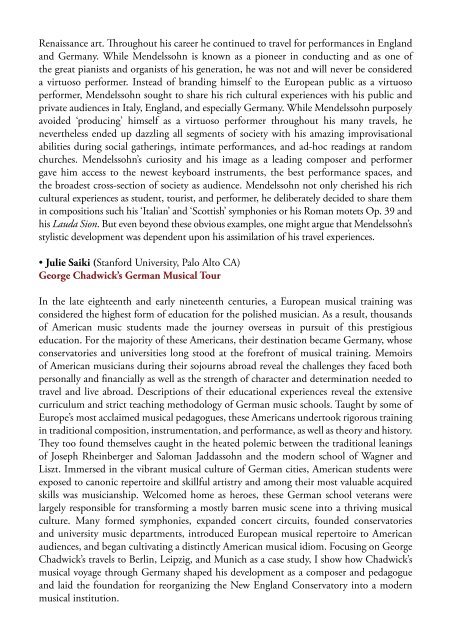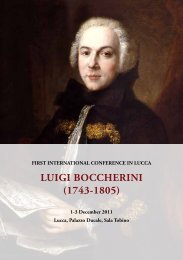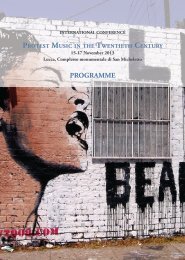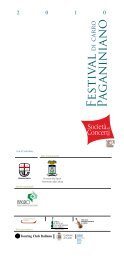the european sound in the era of liszt - Centro Studi Opera Omnia ...
the european sound in the era of liszt - Centro Studi Opera Omnia ...
the european sound in the era of liszt - Centro Studi Opera Omnia ...
- No tags were found...
Create successful ePaper yourself
Turn your PDF publications into a flip-book with our unique Google optimized e-Paper software.
Renaissance art. Throughout his career he cont<strong>in</strong>ued to travel for performances <strong>in</strong> Englandand Germany. While Mendelssohn is known as a pioneer <strong>in</strong> conduct<strong>in</strong>g and as one <strong>of</strong><strong>the</strong> great pianists and organists <strong>of</strong> his gen<strong>era</strong>tion, he was not and will never be considereda virtuoso performer. Instead <strong>of</strong> brand<strong>in</strong>g himself to <strong>the</strong> European public as a virtuosoperformer, Mendelssohn sought to share his rich cultural experiences with his public andprivate audiences <strong>in</strong> Italy, England, and especially Germany. While Mendelssohn purposelyavoided ‘produc<strong>in</strong>g’ himself as a virtuoso performer throughout his many travels, henever<strong>the</strong>less ended up dazzl<strong>in</strong>g all segments <strong>of</strong> society with his amaz<strong>in</strong>g improvisationalabilities dur<strong>in</strong>g social ga<strong>the</strong>r<strong>in</strong>gs, <strong>in</strong>timate performances, and ad-hoc read<strong>in</strong>gs at randomchurches. Mendelssohn’s curiosity and his image as a lead<strong>in</strong>g composer and performergave him access to <strong>the</strong> newest keyboard <strong>in</strong>struments, <strong>the</strong> best performance spaces, and<strong>the</strong> broadest cross-section <strong>of</strong> society as audience. Mendelssohn not only cherished his richcultural experiences as student, tourist, and performer, he delib<strong>era</strong>tely decided to share <strong>the</strong>m<strong>in</strong> compositions such his ‘Italian’ and ‘Scottish’ symphonies or his Roman motets Op. 39 andhis Lauda Sion. But even beyond <strong>the</strong>se obvious examples, one might argue that Mendelssohn’sstylistic development was dependent upon his assimilation <strong>of</strong> his travel experiences.• Julie Saiki (Stanford University, Palo Alto CA)George Chadwick’s German Musical TourIn <strong>the</strong> late eighteenth and early n<strong>in</strong>eteenth centuries, a European musical tra<strong>in</strong><strong>in</strong>g wasconsidered <strong>the</strong> highest form <strong>of</strong> education for <strong>the</strong> polished musician. As a result, thousands<strong>of</strong> American music students made <strong>the</strong> journey overseas <strong>in</strong> pursuit <strong>of</strong> this prestigiouseducation. For <strong>the</strong> majority <strong>of</strong> <strong>the</strong>se Americans, <strong>the</strong>ir dest<strong>in</strong>ation became Germany, whoseconservatories and universities long stood at <strong>the</strong> forefront <strong>of</strong> musical tra<strong>in</strong><strong>in</strong>g. Memoirs<strong>of</strong> American musicians dur<strong>in</strong>g <strong>the</strong>ir sojourns abroad reveal <strong>the</strong> challenges <strong>the</strong>y faced bothpersonally and f<strong>in</strong>ancially as well as <strong>the</strong> strength <strong>of</strong> character and determ<strong>in</strong>ation needed totravel and live abroad. Descriptions <strong>of</strong> <strong>the</strong>ir educational experiences reveal <strong>the</strong> extensivecurriculum and strict teach<strong>in</strong>g methodology <strong>of</strong> German music schools. Taught by some <strong>of</strong>Europe’s most acclaimed musical pedagogues, <strong>the</strong>se Americans undertook rigorous tra<strong>in</strong><strong>in</strong>g<strong>in</strong> traditional composition, <strong>in</strong>strumentation, and performance, as well as <strong>the</strong>ory and history.They too found <strong>the</strong>mselves caught <strong>in</strong> <strong>the</strong> heated polemic between <strong>the</strong> traditional lean<strong>in</strong>gs<strong>of</strong> Joseph Rhe<strong>in</strong>berger and Saloman Jaddassohn and <strong>the</strong> modern school <strong>of</strong> Wagner andLiszt. Immersed <strong>in</strong> <strong>the</strong> vibrant musical culture <strong>of</strong> German cities, American students wereexposed to canonic repertoire and skillful artistry and among <strong>the</strong>ir most valuable acquiredskills was musicianship. Welcomed home as heroes, <strong>the</strong>se German school vet<strong>era</strong>ns werelargely responsible for transform<strong>in</strong>g a mostly barren music scene <strong>in</strong>to a thriv<strong>in</strong>g musicalculture. Many formed symphonies, expanded concert circuits, founded conservatoriesand university music departments, <strong>in</strong>troduced European musical repertoire to Americanaudiences, and began cultivat<strong>in</strong>g a dist<strong>in</strong>ctly American musical idiom. Focus<strong>in</strong>g on GeorgeChadwick’s travels to Berl<strong>in</strong>, Leipzig, and Munich as a case study, I show how Chadwick’smusical voyage through Germany shaped his development as a composer and pedagogueand laid <strong>the</strong> foundation for reorganiz<strong>in</strong>g <strong>the</strong> New England Conservatory <strong>in</strong>to a modernmusical <strong>in</strong>stitution.









